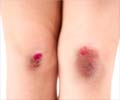Highlights
- Antibiotic infused spider silk was developed by a research team from the University of Nottingham.
- This spider silk is found to release antibiotic and prevent colonization of microbes.
- It could be used as bandages for wound healing, regenerative medicine and drug delivery.
Click Chemistry
The research team from Nottingham University showed how click-chemistry could be used to attach fluorescent molecules or antibodies to spider silk that is artificially produced by E.coli.Click chemistry was a term coined by K. B. Sharpless in 2001 to detail high yielding reactions with a wide scope, and which results in byproducts that can be separated without the need for chromatography. This methodology was conceptualized to cater to the needs of the materials, pharmaceutical and other industries to generate large libraries of compounds that are required in research for screening.
The molecules that are chosen should be 'clicked' within soluble silk protein, prior to turning them into fibers or even after the development of the fibers. There is a lot of control that can be exerted in the development of these fibers and they can be clicked with more than one type of molecule.
Recombinant Technology
The antibiotic levofloxacin was added onto the silk fibers and was slowly released from the fibers for at least 5 days. Dr. Neil Thomas who is a Professor of Medicinal and Biological Chemistry said that the technique allowed fast generation of biocompatible silk structures with mono or multiple functions which could be used for a range of applications. The research team said that this technology could be particularly useful in tissue engineering and biomedicine.Benefits of Spider Silk
- Spider silk is strong, biodegradable and biocompatible.
- This material is based on protein and does not lead to a strong immune, inflammatory or allergic reaction.
The recent advances in recombinant spider silk technology have resulted in a race to find ways to harness these qualities.
- The technique can be used to develop a biodegradable mesh.
- It can be used to replace the extracellular matrix generated by our own cells.
- This will aid in the acceleration of the new tissue.
- It is also useful in the slow release of antibiotics.
- It could be used for the treatment of wounds that are slow healing like diabetic ulcers.
- Infection of wounds can be prevented for weeks or even months by controlling the release of the antibiotics.
- Regeneration of the wound tissue is accelerated by the temporary scaffold provided by silk fibers. The silk fibers are biodegraded after that.
Historical Significance of Spider Silk
Historically, the medicinal properties of spider silk have been known for many centuries. Greek and Roman soldiers were bandaged with spider silk to prevent bleeding. Honey and vinegar were used to clean deep wounds while balled up spider webs were used to cover the wound.The scientists included a method in which the silk proteins were produced in a bacterium and an amino acid that was not normally found in a protein was included. The amino acid that contained the azide group was widely used in click reactions.
Dr. Goodacre, another key researcher in the study said that it was a fascinating adventure in identifying the amino acid and also incorporating the fibers with antibiotics.
The use of spider silk could revolutionize wound healing, as the risk of infection is high during this phase. When wounds are covered with such recombinant technology, where spider silk releases antibiotics for a period of time, the risk of infection is minimized. Spider silk is already believed to have antimicrobial effect for a short period of time, infusing their fibers with antibiotics increases the antimicrobial effect and duration.
References:
- David Harvey, Philip Bardelang, Sara L. Goodacre, Alan Cockayne, Neil R. Thomas. Antibiotic Spider Silk: Site-Specific Functionalization of Recombinant Spider Silk Using “Click” Chemistry. Advanced Materials, (2016); 1604245 DOI: 10.1002/adma.201604245
- Azide-Alkyne Cycloaddition - (http://www.organic- chemistry.org/namedreactions/click-chemistry.shtm)
















